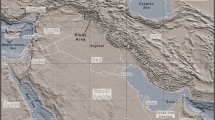Abstract
The platinum-bearing Paleoproterozoic Vurechuaivench Massif in the Monchegorsk Pluton is made up of amphibolized and saussuritized gabbronorites, anorthosites, and norites. The geochemical features of the massif rocks are considered at four detailed areas. It was confirmed that the Vurechuaivench and Nyud-Poaz massifs are geochemically similar. The rare-earth element (REE) distribution in the rocks of the Vurechuaivench Massif is peculiar in the low total REE content (9.4–27.6 ppm), negative REE slope, significant LREE enrichment [La/Yb] n = 3.7–8.7), and distinctly expressed positive Eu anomaly ([Eu/Eu*] n = 1.2–2.2). The REE distribution pattern remains unchangeable throughout the entire section, including the rocks of the Pt reef, with a gradual upsection REE increase. It is suggested that the PGE reef of the Vurechuaivench Massif, as the Platinova Reef (Skaergaard massif) and Sonju-Lake Intrusion (Duluth complex), was formed during fractional crystallization in a large magma chamber without new magma influx. It is conceivable that the Vurechuaivench Massif is the allochthonous fragment of a large loppolith-like body, the lower portions of which compose the Nyud-Poaz Massif, while the middle part was almost completely eroded.
Similar content being viewed by others
References
E. K. Kozlov, Natural Rock Series of the Nickel-Bearing Intrusions and Their Metallogeny (Nauka, Leningrad, 1973) [in Russian].
Layered Intrusions of the Monchegorsk Ore District: Petrology, Mineralization, Isotopy, and Deep Structure (Izd-vo KNTs RAN, Apatity, 2004), Vol. 1 [in Russian].
Yu. A. Balashov, T. B. Bayanova, and F. P. Mitrofanov, “Isotope data on the age and genesis of the layered basic-ultrabasic intrusions in the Kola Peninsula and Northern Karelia, northeastern Baltic Shield,” Precambrian Res. 64(1–4), 197–205 (1993).
V. N. Ivanchenko, P. S. Davydov, V. A. Dedeev, and V. V. Knauf, “Main geological features of the Vurechuaivench deposit. International cooperation and sharing the skill in geological study and prospecting of PGE deposits in the northern Fennoscandia,” in Intermediate results of International Project KOLARCTIC INTERREG III A North -TACIS N KA-0197 “Strategic Mineral Resources as the Basis for Steady Development in the North”, Russia-Finland-Sweden, 2008 (Izd-vo KNTs RAN, Apatity, 2008), pp. 82–87 [in Russian].
T. L. Grokhovskaya, G. F. Bakaev, E. P. Shelepina, M. I. Lapina, I. P. Laputina, and G. N. Muravitskaya, “PGE mineralization in the Vuruchuaivench gabbronorite massif, Monchegorsk Pluton (Kola Peninsula, Russia),” Geol. Ore Dep. 42(2), 133–146 (2000).
T. L. Grokhovskaya, G. F. Bakaev, V. V. Sholokhnev, M. I. Lapina, G. N. Muravitskaya, and V. S. Voitekhovich, “The PGE ore mineralization in the Monchegorsk magmatic layered complex (Kola Peninsula, Russia),” Geol. Ore Dep. 45(4), 287–308 (2003).
V. V. Knauf, P. S. Davydov, and V. N. Ivanchenko, “Noble metal mineralization at the Vuruchuaivench prospecting area. International cooperation and sharing the skill in geological study and prospecting of PGE deposits in the northern Fennoscandia,” in Intermediate results of International Project KOLARCTIC INTERREG III A North -TACIS N KA-0197 “Strategic Mineral Resources as the Basis for Steady Development in the North”, Russia-Finland-Sweden, 2008 (Izd-vo KNTs RAN, Apatity, 2008), pp. 88–97 [in Russian].
Imandra-Varzuga Karelide Zone: Geology, Geochemistry, and Evolution (Nauka, Leningrad, 1982) [in Russian].
P. V. Pripachkin and T. V. Rundkvist, “Geological structure and Pt potential of the southwestern part of the Vurechuaivench foothills, Monchegorsk Complex, Kola Peninsula,” Rudy Met., No. 5, 61–68 (2008).
V. N. Ivanchenko and P. S. Davydov, “Main geological features of the PGM deposits of the southern Monchegorsk ore district,” in Interreg-Tasis Project: Strategic Mineral Resources of Lapland as the Basis for Stable Evolution of the North (Izd-vo KNTs RAN, Apatity, 2009), pp. 70–78 [in Russian].
Petrographic Code (Izd-vo VSEGEI, St. Petersburg, 2009) [in Russian].
Yu. A. Balashov and N. M. Sushchevskaya, “Rare-earth elements in the stratified ultrabasic intrusions,” Geokhimiya, No. 12, 1823–1830 (1973).
W. F. McDonough and S. S. Sun, “The composition of the Earth,” Chem. Geol. 120, 223–253 (1995).
H. R. Rollinson, Using Geochemical Data: Evaluation, Presentation, Interpretation (Longman, Singapore, 1993).
E. V. Sharkov, Formation of the Layered Intrusions and Related Mineralization (Nauchnyi mir, Moscow, 2006) [in Russian].
F. P. Lesnov, Rare-Earth Elements in the Ultramafic and Mafic Rocks and Their Minerals. Book 1. Major Rock Types. Rock-Forming Minerals (“Geo”, Novosibirsk, 2007) [in Russian].
M. K. Sukhanov, N. G. Bogdanova, S. M. Lyapunov, and B. V. Ermolaev, “Geochemistry of the rare-earth elements of autonomous anorthosites,” Geokhimiya, No. 2, 184–194 (1990).
A. V. Chistyakov, M. K. Sukhanov, O. A. Bogatikov, N. G. Grinevich, T. L. Grokhovskaya, S. M. Lyapunov, and E. V. Sharkov, “Distribution of trace and rare earth elements in the Burakovka layered intrusion, South Karelia, Russia,” Dokl. Earth Sci. 356(3), 1066–1071 (1997).
F. P. Mitrofanov, “Plume processes from the view point of general and regional geology. Tectonics and geodynamics of continental lithosphere,” in Proceedings of 36th Tectonic Conference, Moscow, Russia, 2003 (Geos, Moscow, 2003), pp. 60–62 [in Russian].
E. V. Borodina, A. E. Izokh, and A. A. Mongush, “The Bulka peridotite-gabbro intrusion (West Sayan), a syncollisional type of layered intrusions,” Russ. Geol. Geophys. 52(3), 307–319 (2011).
A. J. Naldrett, Magmatic Sulfide Deposits of Copper-Nickel and PGE Ores (SPbGU, St. Petersburg, 2003) [in Russian].
T. V. Rundkvist, P. V. Pripachkin, and R. A. Grebnev, “On problem of the geological structure and PGE potential of the eastern Monchegorsk Complex (Kola Peninsula): Evidence from Cumulus Stratigraphy,” in Interreg-Tasis Project: Strategic Mineral Resources of Lapland as the Basis for Stable Evolution of the North (Izd-vo KNTs RAN, Apatity, 2009), pp. 51–64 [in Russian].
Author information
Authors and Affiliations
Corresponding author
Additional information
Original Russian Text © R.A. Grebnev, T.V. Rundkvist, P.V. Pripachkin, 2014, published in Geokhimiya, 2014, No. 9, pp. 791–806.
Rights and permissions
About this article
Cite this article
Grebnev, R.A., Rundkvist, T.V. & Pripachkin, P.V. Geochemistry of mafic rocks of the PGE-bearing Vurechuaivench Massif (Monchegorsk Complex, Kola region). Geochem. Int. 52, 726–739 (2014). https://doi.org/10.1134/S0016702914070027
Received:
Accepted:
Published:
Issue Date:
DOI: https://doi.org/10.1134/S0016702914070027




